日本科技振兴机构促进科学和数学教育发展
201841比较教育学作业及答案陕西师范大学网络教育学院专升本

《比较教育学》作业.单选题.1、比较教育学界人们常说的“比较教育之父”是( )。
A.阿尔特巴赫B. 康德尔C. 萨德勒D. 朱利安答案:(1)、ylitw2008(2)↑↑↑微信↑↑↑(3)智金宝资料库2、结构功能主义对比较教育的影响,主要表现为比较教育注重对( )之间的关系进行分析和研究。
A、教育与民族特性B、教育与民族传统C、教育与国民性D、教育与社会3、( )年布什总统签发了由教育部长亚历山大负责起草的全美教育改革文件——《美国2000:教育战略》A. 1985 B .1989 C . 1991 D. 19964、美国第一所注重学术研究的研究型大学是()。
它首先创立研究生院,强调教学与科研的统一。
A.哈佛大学B. 哈佛学院C.约翰霍普金斯大学D.赠地大学5、美国教育行政是典型的()。
A.地方分权制B.中央集权制C.中央与地方协作制6、英国独立学校是指( )的学校。
A.不接受教育和科学部补助,但接收地方教育当局补助B.接受教育和科学部补助,但不接收地方当局补助C.既不接受教育和科学部补助,也不接收地方当局补助D.既接受教育和科学部补助,也接收地方当局补助7、( )年德国教育审议会议提出了《教育结构计划》的改革方案,这是根本改革联邦德国教育制度的蓝图。
A.1945 B .1968 C .1970 D.19738、法国是一个中央集权的国家,设立的中央教育行政机构为( )。
A 联邦教育部B 教育和科学部C 文部省D 国民教育部9、法国现代()是法国高等教育的主体,由()管理。
A.大学校、各地方学区B.综合大学、各地方学区C.大学校、政府各部D.综合大学、政府各部10、1951年,日本制定( ),规定产业教育是发展产业经济及提高国民生活的基础。
A. 《学校教育法》B.《教育基本法》C.《实业学校令》D.《产业教育振兴法》11、日本现行的中央教育行政机构是( B )A. 教育部B. 文部省C. 国家教委D.联邦教育部12、比较教育学学科的特殊性决定了()是其最基本的研究方法。
学前教育原理与应用 第九章 幼儿园教育与小学、家庭、社区教育的衔接
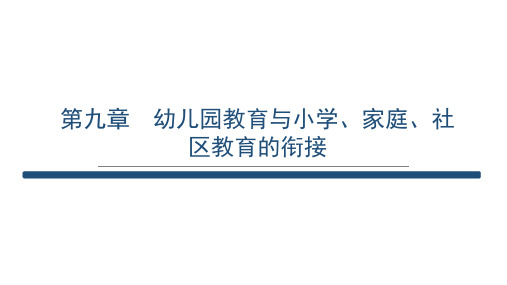
一、幼小衔接工作的意义及现状
(三)国外发达国家幼小衔接的做法
1.教育机构设置方面
(3)瑞士各州都有自己的教育制度。 (4)英国的初等教育分为2—5岁儿童的保育学校、5—7岁儿童的幼儿 学校和7—11岁儿童的初级学校。 (5)日本建立“幼小一贯学校”的计划。
二、幼小衔接工作的内容和方法 (三)幼小衔接工作的主要内容
• 召开家长会或举办家庭教育讲座。
3.家长
• 向家长发放幼小衔接相关的资料。 • 办好“家长园地” 。
• 家访、家园联系卡等方式对个别家长进行教育指导。
第二节 幼儿园与家庭、社区教育的合作
一、幼儿园与家庭、社区合作的概述
(一)对家庭、社区的界定
1. 教育、教学权 2. 科学研究和学术活动权 3. 管理幼儿权 4. 指导和评定幼儿的权利 5. 按时获取报酬的权利 6. 参加进修、培训的权利 7. 参与幼儿园民主管理权
一、幼儿园与家庭、社区合作的概述
(二)家庭、社区与学前教育
1. 儿童生活的场所及其周边环境,如家庭、幼儿园、邻居和社区,其中 如幼儿园与家庭、幼儿园与社区、家庭与社区之间的关系或联系,对 儿童的发展有很大的影响。
一、幼小衔接工作的意义及现状
(三)国外发达国家幼小衔接的做法
5.政策制度与政府监督方面
(3)美国 2001年颁布《不让一个孩子落后》的教育法令,其目的是改革从幼儿园到 十二年级的教育,将学前教育中的阅读和幼小衔接作为优先发展的领域。 2003年颁布了《入学准备法》,强调美国政府和教育主管部门对幼儿园与 小学的教育行政机构进行整合,以便更好地为幼小衔接提供服务。
日本现行教育制度

日本实施初等教育的机构是单一的六年制小学,儿童满6周岁入学,12周岁毕业,属于义务教育阶段。新学 年从4月份开学,多数小学采用三学期体制,三学期之间分别为暑假、寒假和春假。
日本小学的教育目的是适应儿童的导心发展,实施初等普通教育。教育目标: (1)以学校内外的社会生活的经验为基础。使学生正确理解人与人之间的相互关系,养成合作、自主和自律 的精神。 (2)引导学生正确理解乡十和国家的现状与传统,并进而培养国际协作精神。 (3)使学生具有日常生活所必需的衣、食、住和产业等方面的基础知识,并掌握基本技。 (4)使学生能正确理解日常生活所必需的国语,并形成使用国语的能力。 (5)使学生能正确理解日常生活所必需的数量关系,并形成处理数量关系的能力。 (6)培养学生科学地观察和处理日常生活中自然现象的能力。 (7)培养学生健康、安全和幸福生活所必需的习惯,并力求使学生的身心得到和谐发展。 (8)使学生基本了解能够使生活明朗、丰富的音乐、美术和文艺等,并形成相应的技能。
教育行政体制
1.中央教育行政 日本现行的中央教育行政机构是文部科学省,为日本内阁的组成部分,其最高领导是文部大臣。文部大臣和 文部科学省是主管教育行政的中央首长和行政机关。法律规定文部省的职能权限,主要是: (1)为发展教育、学术和文化事业,进行调查研究并制定规划。 (2)就各级学校和教育机构的设施设备、人员配置、组织与教育内容规定标准。 (3)对地方教育委员会、地方行政机关,大学和其他教育、文化与科学机构提供指导和建议。 (4)管理由文部科学省设立的大学和其他教育、科学与文化机构,任命县和重要市的教育长或负责人,审定 中小学教科书。 (5)对地方教育和其他教育、文化与科研机构提供经费补助。 2.地方教育行政 法律规定,地方教育由地方公共团体实行自治。日本的地方公共团体分为两纵即都道府县和市町村。教育的 行政机关为教育委员会,行政主管为教育长。
科教兴国战略

科教兴国战略1979年以来,经济增长速度举世瞩目。
但其增长点主要依靠资源、资金和廉价劳动力推动的外延式、粗放式的经济。
从现在起到21世纪中叶,是实现中国现代化建设三步走战略目标的关键历史时期。
实现国民经济持续、快速、健康发展,必须依靠,以解决好产业结构不合理、技术水平落后、劳动生产率低、经济增长质量不高等问题,从而加速国民经济增长从外延型向效益型的战略转变。
为此,中国于1995年宣布,决定实施的战略。
1995年5月,江泽民同志在全国科技大会上的讲话中提出了实施科教兴国的战略,确立科技和教育是兴国的手段和基础的方针。
这个方针大大提高了各级干部对科技和教育重要性的认识,增强了对科学技术是第一生产力的理解。
实施“科教兴国”战略,既要充分发挥科技和教育在兴国中的作用,又要努力培植科技和教育这个兴国的基础。
在当前,更要着重加强和扶持科技与教育,为国家的近期发展和长期稳定发展打好基础。
提高生产者对经济增长的贡献率,尽快地建立起高科技企业,同时要加强提高国民素质,加强基础教育,注重人才的培养,重视创造性的科研工作。
科技和教育具有双重的功能,既能为当前社会经济的发展提供各种手段,又为持续的、长远的发展提供必要的基础。
今天科技和教育能够为经济和社会的发展提供知识、技术、人才,从而提供效益,是在此之前的科技和教育的投入所作的回报。
科教兴国战略的主要内容是:在科学技术是第一生产力思想的指导下,坚持教育为本,把科技和教育摆在经济、社会发展的重要位置,增强国家的科技实力及向现实生产力转化的能力,提高全民族的科技文化素质,把经济建设转移到依靠科技进步和提高劳动者素质的轨道上来,加速实现国家的繁荣昌盛。
科教兴国战略对中国科技发展的目标作出了规定:到2000年的目标是,初步建立适应社会主义市场经济体制和科技自身发展规律的科技体制。
在工农业科学研究与技术开发、基础性研究、高技术研究等方面取得重大进展。
科技进步对经济发展的贡献率有显着提高。
2024年天津继续教育公需科目知识题及答案
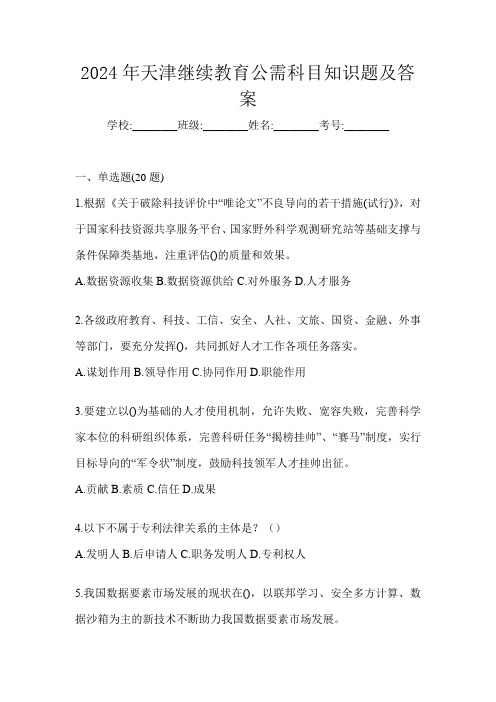
2024年天津继续教育公需科目知识题及答案学校:________班级:________姓名:________考号:________一、单选题(20题)1.根据《关于破除科技评价中“唯论文”不良导向的若干措施(试行)》,对于国家科技资源共享服务平台、国家野外科学观测研究站等基础支撑与条件保障类基地,注重评估()的质量和效果。
A.数据资源收集B.数据资源供给C.对外服务D.人才服务2.各级政府教育、科技、工信、安全、人社、文旅、国资、金融、外事等部门,要充分发挥(),共同抓好人才工作各项任务落实。
A.谋划作用B.领导作用C.协同作用D.职能作用3.要建立以()为基础的人才使用机制,允许失败、宽容失败,完善科学家本位的科研组织体系,完善科研任务“揭榜挂帅”、“赛马”制度,实行目标导向的“军令状”制度,鼓励科技领军人才挂帅出征。
A.贡献B.素质C.信任D.成果4.以下不属于专利法律关系的主体是?()A.发明人B.后申请人C.职务发明人D.专利权人5.我国数据要素市场发展的现状在(),以联邦学习、安全多方计算、数据沙箱为主的新技术不断助力我国数据要素市场发展。
A.技术融合层面B.区域发展层面C.技术发展层面D.区域融合层面6.《关于支持和鼓励事业单位专业技术人员创新创业的指导意见》提出,在事业单位设置(),有助于充分发挥高校、科研院所等事业单位人力资源和技术资源优势,加快推动科技创新。
A.流动岗位B.技术岗位C.管理岗位D.创新岗位7.提升()发展水平,加快推进院校办学条件达标,做强高职专科教育,推进本科层次职业教育。
A.高等教育B.学前教育C.义务教育D.职业教育8.《关于实行以增加知识价值为导向分配政策的若干意见》提出,激发广大科研人员的积极性、主动性和创造性,鼓励多出成果、快出成果、出好成果,推动()加快向现实生产力转化。
A.科研项目B.科技成果C.基础研究D.应用研究9.《关于进一步加强党委联系服务专家工作的意见》提出,各级党委(党组)要把()作为科学决策、民主决策、依法决策的重要方式之一。
2021国际人类遗传资源数据共享管理现状及启迪范文1

2021国际人类遗传资源数据共享管理现状及启迪范文 摘要: 人类遗传资源对推进生命科学研究和促进医药产业发展具有重要意义。
随着精准医学战略的实施和基因编辑技术的不断成熟, 各国对人类遗传资源的争夺及其相关科技发展和产业的竞争愈发激烈。
经济合作与发展组织 (OECD) 作为最重要的国际经济组织, 其指南的制定通常是围绕各国政府普遍关注的科学进步和科学效率问题, 从国家和全球公共利益的角度出发, 提出应对技术发展、科研范式变化的方案, 近年来美国、日本和英国等发达国家也出台了相应的遗传资源数据共享政策和管理指南。
本文旨在通过对OECD提出的人类遗传资源共享指南和以美国、英国、日本为代表的技术发达国家在实践中的管理要点进行分析, 为提高中国人类遗传资源共享的监管效力, 促进资源的合法共享和有效利用提供参考。
关键词: 人类遗传资源;经济合作与发展组织; 美国; 英国; 日本; 数据共享; Abstract: Humangenetic resources are valuable for life science research and pharmaceutical petitions for human genetic resources and the relevant techniques and industries have increasingly become intense among countries with the the implementation of precision medicine strategy and the maturity of gene editing technology.In the context of scientific progress and efficiency, the Organisation for Economic Co-operation and Development, the most important international economic organization, has proposed solutions to technological development and research paradigm changes from the perspective of national and global public interests.The United States, Japan, the United Kingdom, and some other developed countries have also released their policies and guidelines on the sharing of genetic resource data.In this article we analyzed these policies and guidelines, with an attempt to further improve the administration of human genetic resource sharing in China and promote the legal sharing and effective use of these resources. Keyword: humangenetic resource; Organisation for Economic Co-operation and Development; United States; United Kingdom; Japan; data sharing; 人类遗传资源是指含有人体基因组、基因及其产物的器官、组织、细胞、血液、制备物、DNA构建体等遗传材料及相关的信息资料[1],对推进生命科学研究和促进医药产业发展等具有重要意义。
学前比较教育

学前⽐较教育1、有准备的环境:是⼀个即适合⼉童发展的的节奏和步调⼜与成⼈环境有关联,既能使⼉童⾃由操作⼜对活动材料有所限制的⼀个充满⾃由、爱、营养、快乐与便利的环境。
2、《青少年福利法》:1924年德国政府制定了此法律,规定了⼉童受教育的权利以及家庭教育在学前教育中的优先地位,该法案基本上定下了现代的国学前教育的基调,即把学前教育视为青少年福利事业。
3、进步主义幼⼉园:20世纪30—40年代在美国开展的,是当时进步主义教育运动的重要组成部分,⽬的是摆脱幼⼉教育中福利贝尔正统派的形式主义,弘扬福利贝尔理论中的合理因素,加强幼⼉教育与社会⽣活及⼉童⽣化的联系,希尔史这场运动的杰出领导⼈。
4、光谱⽅案:多元智⼒理论在实践中的⼀种课程⽅案,由哈佛⼤学加德纳教授和塔夫茨⼤学的费尔德曼教授率领哈佛⼤学零岁⽅案⼯作组和塔夫茨⼤学的研究⼩组合作完成的早期学习活动研究⽅案。
⽅案围绕⼋套关键能⼒开展活动,课程以⼉童的强项为线索,带动⼉童整体的发展。
5、语⾔所:语⾔所起源于1982年的⽑利⽂化再⽣运动。
主要⽬的在于⽀持和⿎励使⽤⽑利语⾔和⽂化。
1989年所成为新西兰的第四⼤学前教育机构,语⾔所的看护者⼀般为年纪较⼤的妇⼥,须熟悉⽑利的传统流利的⽑利语。
以家庭为基础,课程⼀般在会议室内进⾏。
管理和资⾦由⽑利⼈事部和国家语⾔所联合体主管6、“母育学校”:法国学前教育机构的名称,先驱是凯果玛,在1881年法国颁布法令将各种教育机构的名称统⼀为“母育学校”,并延续⾄今。
母育学校要是是“母性养护及早期教育”,对全体⼉童进⾏体、德、智全⾯发展的教育,招收2—6岁⼉童,按年龄编班。
7、美国发展适宜性课程:发展适宜性课程把适应⼉童的发展作为决定课程质量诸因素中的重要因素,重视⼉童的年龄发展特点,即个别⼉童发展差异,反映了课程发展的综合趋势。
主要观点:(1)认为游戏是⼉童发展的主要⽅式和最好的显⽰器。
(2)成⼈和⼉童关系的质量,成⼈与⼉童的⽐例以及班级的⼈数。
奥鹏作业当代外国学前教育在线作业2-0001

当代外国学前教育19春在线作业2-0001
日本厚生省同时公布了《儿童福利法施行令》和《儿童福利法施行规则》两个法令的时间是()。
选项【A】:1928年
选项【B】:1948年@@1988年
选项【C】:1888年
正确选项:B
瑞吉欧支持、实践着一种课程设计方法是()。
选项【A】:教师生成课程
选项【B】:自然生成课程
选项【C】:预先设计课程
选项【D】:生活课程
正确选项:B
美国学前社会性学习的目的包括()。
选项【A】:促进自尊心的发展
选项【B】:促进思维的发展
选项【C】:促进数学概念的发展
选项【D】:促进自然科学概念的发展
正确选项:A
美国先行教育到达目的的途径不包括()。
选项【A】:提高儿童的健康水平
选项【B】:提高幼儿的智力水平
选项【C】:鼓励儿童的自主、自信的发展选项【D】:发展儿童对成功的期望
正确选项:B
战争时期幼儿教育的倾向是()。
research funding agencies for examples

research funding agencies for examples
1.国家自然科学基金委员会(NSFC):NSFC是中国最大的研究资助机构之一,致力于支持科学研究和创新。
该机构提供资金支持不同领域的研究项目,包括数学、物理、化学、生物学、医学等。
2. 欧盟委员会:欧盟委员会资助各种研究项目,包括基础研究、应用研究和开发研究。
该机构通过提供资金和其他资源来帮助研究人员开展科学研究。
3. 美国国家科学基金会(NSF):NSF是美国最大的研究资助机构之一,致力于支持基础研究和教育。
该机构提供资金支持不同领域的研究项目,包括物理学、化学、生物学、数学等。
4. 德国研究基金会(DFG):DFG是德国最大的研究资助机构之一,致力于支持科学研究和创新。
该机构提供资金支持不同领域的研究项目,包括自然科学、工程学、医学、社会科学等。
5. 日本学术振兴会(JSPS):JSPS是日本最大的研究资助机构之一,致力于支持科学研究和学术交流。
该机构提供资金支持不同领域的研究项目,包括自然科学、社会科学、人文学等。
总的来说,研究资助机构在促进科学研究和创新方面发挥着重要作用。
研究人员可以通过申请这些机构提供的资助来开展自己的研究项目,从而推动科学研究的发展。
- 1 -。
《当代外国学前教育》离线作业考核

离线作业考核《当代外国学前教育》一、名词解释题(每小题6分,24分)1. 分析法分析法是“综合法”的对称。
把复杂的经济现象分解成许多简单组成部分,.分别进行研究的方法。
2.发展成熟论课程模式是指美国现代早期教育的课程模式。
以弗洛伊德的精神分析理论和盖塞尔的成熟论为理-论基础设计。
3.克鲁普斯卡娅全名叫娜杰日达.康斯坦丁诺夫娜克鲁普斯卡娅,女,苏联杰出的教育家,无产阶级政治活动家,革命导师弗拉基米尔.伊里奇.乌里扬诺夫(列宁)的夫人和亲密战友。
她一生致力于研究马克思主义的教育科学,并担任苏维埃教育领导工作,做出了突出贡献。
被誉为“苏联国母”以及“苏联第一夫人”1939年2月27日因病辞世,享年70岁。
4.先行教育得分教育先行,亦称教育超前,就是要求教育要面向未来,使教育在适应现存生产力和政治经济发展水平的基础上,适当超前于社会生产力和政治经济的发展。
二、简答题(每小题12分,共60分)1.日本第三个“幼儿园教育振兴计划”的主要内容是什么?2. 蒙台梭利提出的有准备的环境的要求是什么?创设有规律、有秩序的生活环境。
提供有吸引力的、美的、实用的设备和用具。
允许儿童独立活动,自由表现,使儿童意识到自己的力量。
丰富儿童的生活印象。
促进幼儿智力的发展。
培养儿童的社会性行为。
3.瑞吉欧幼儿教育体系中开放的、新形态的环境有什么特点?1.开放的环境是幼儿园的第三位老师。
2.环境是产生互动的容器,具有教育性价值。
3.充分利用墙面,把墙面作为记录儿童作品的场所,让墙面说话。
4. 日本幼儿园教育指导方法遵循的教育原理是什么?5.20世纪60年代,美国重视学前教育的原因是什么?1.科学技术的飞跃发展。
2.学前教育理论中的一些重要观点发生了变化。
3.家庭结构发生了变化。
《当代外国学前教育》练习题参考答案一、名词解释1.文献法文献法是通过分析重要的学前教育文件来了解外国学前教育情况的一种方法。
2.美国幼儿园幼儿园以公立为主,公立幼J园绝大部分附设于初等学校,成为初等学校的一部分。
多元文化交流与教育公平

Gl 0 r i a L a d s o n — B i l l i n g s 、 El i z a b e t h Ki n g 、 Di n a Me h me d —
韩两国间的学术交流 以及 中韩两国的友好关系。
除
荸
衔
林 晓: 硕士生 。
收稿 日 期: 2 0 1 2 — 1 1 一 o 4
1 3
勤 悠
务教育优质资源均衡发展研究》 报告 中指 出, 我国义 务教育均衡发展已经实现了从权利平等到资源均衡 的转变 , 正从资源均衡向优质均衡迈进 , 义务教育优
男女两性的受教育公平问题一直是教育公平问 题的研究热点 。 在本次会议上 , 性别公平问题又一次 成为众 多学者讨 论 的焦点 之一 。 北 京师范 大学 的 M. A b i d M a l i k 在《 教育 中的性别差异 : 地域和宗教 , 哪
个更紧要? 》 中指出, 与地域相 比, 宗教或者信仰问题 更容易造成教育中的性别差异。北京师范大学张莉 莉阐述了《 从问题分析到机构创新 : 帮助更多教师成
为少数领域的领导者》 , 从女性领导力方面对教育领 域男女不平等问题作 了深入细致的分析 ,并提出切 实可行的提高女性领导力 的途径和培养措施。她认 为, 造成女性领导力低下主要有传统刻板印象、 女性
L i e k e V a n d e Wi e l 作 了题为《 教育权利下放对教育平 等影响》 的主题报告 , 从另外一个角度重新审视教育 的公平与质量问题 , 认为教育权利下放赋予了学校 共同体更多的权利、 均衡资源分配管理和问责 , 也有 利于拓宽社区的参与广度。 大会还讨论了区域差异与教育公平问题。新疆
《现代农业研究》首次被《日本科学技术振兴机构数据库(JST)》收录

《现代农业研究》首次被《日本科学技术振兴机构数据库
(JST)》收录
佚名
【期刊名称】《现代农业研究》
【年(卷),期】2024(30)5
【摘要】据《日本科学技术振兴机构数据库(JST)》最新公布名单显示,《现代农业研究》被列为收录检索源期刊,这是本刊首次被国外数据库收录。
《日本科学技术
振兴机构数据库(JST)》(原日本科学技术社数据库)由日本科学技术振兴机构于2007年首次建立。
【总页数】1页(PF0002)
【正文语种】中文
【中图分类】TP3
【相关文献】
1.《现代农业研究》首次被《日本科学技术振兴机构数据库(JST)》收录
2.《现代
农业研究》首次被《日本科学技术振兴机构数据库(JST)》收录3.《现代农业研究》首次被《日本科学技术振兴机构数据库(JST)》收录4.《现代农业研究》首次被《日本科学技术振兴机构数据库(JST)》收录5.《现代农业研究》首次被《日本科
学技术振兴机构数据库(JST)》收录
因版权原因,仅展示原文概要,查看原文内容请购买。
科技政策学

东北大学继续教育学院科技政策学试卷(作业考核线上) A 卷学习中心:辽宁锦州电大奥鹏学习中心[10]B院校学号:C44160111090023姓名王梁(共 6 页)总分题号一二三四五六七八九十得分一、判断题(判断下列各题对错,将其标号填入下表中,正确填√,错误填×,每题1分,共10分)题号 1 2 3 4 5 6 7 8 9 10 答案×××√√√√√√√1、在近代以前,技术依附哲学,科学依附工匠。
2、近代以后,科学与技术的发展呈现两条平行线。
3、罗马俱乐部关于人类面临空前困境的天才预言一发表就得到了世人的认可。
4、自主创新是创新型国家建设的必由之路。
5、《美国竞争法案》被誉为美国21世纪科学事业发展的路线图。
6、企业是技术创新的主体。
7、2006年的第四次全国科技大会上胡锦涛做了“走中国特色自主创新道路,为建设创新型国家而奋斗”的讲话。
8、《中华人民共和国科学技术进步法》1993年颁布。
9、现代科技决策模式已由政治精英模式、专家模式向公众模式演进。
10、财税政策、人才政策等属于科技政策的支撑体系。
二、单项选择题(在下列各题的四个备选答案中,选出一个正确的,将其答案标号填入下表内,每题1分,共10分)题号 1 2 3 4 5 6 7 8 9 10 答案 A A B D D C B B C A1、当前世界科技发展的主要特点是科学、技术、(A )一体化趋势更加显现。
A)生产B)销售C)教育D)研究2、科技政策的分类(A )A)科学政策与技术政策B)科学政策与政府政策C)技术政策与国家政策D)国家政策与模糊政策3、美国在(B )年成立国家宇航局,负责制定国家狂减发展计划。
A)1930—1940 B)1957—1958 C)1960—1963 D)1964—19664、不唯书、不唯上、只唯实的思维是要打破(D )A)先入为主的刻板印象B)以点带面的晕轮效应C)刚愎自用的经验思维D)迷信权威的僵化思维5、以下哪一个不是21世纪世界各国科技政策的共同特点(D )A)加强研究设施建设B)开发人力资源C)增加科技投入D)变革组织体制6、日本科技战略转变意味着(C )A)模仿—原始创新—自主创新B)自主创新—模仿—科技发明C)模仿—自主创新—原始创新D)自主创新—科技发明7、“科学技术是生产力”是在第几次全国科学技术大会上提出的(B )A)第一次B)第二次C)第三次D)第四次8、下列哪项不是我国科技发展具备的优势(B )A)科技人力资源总量世界第一B)研发人员总量世界第五C)高薪技术产业群迅速崛起D)一批拥有自主知名品牌的优秀企业9、我国第一个国家科技发展长期规划是在哪一年提出的(C)?A)1978 B)1981 C)1983 D)198510、科技政策的支撑体系(A )A)科技财税政策与科技人才政策B)科技财税政策与科技创新政策C)科技人才政策与科技教育政策D)科技投入政策三、多项选择题(在下列各题的备选答案中,选出正确的,将其答案标号填入下表内,每题2分,共20分。
2023继续教育工程发展与应用(16课时)题库

单选题(共30题,每题2分)1 .芯片的良率与尺寸呈现怎样的关系?()A.随着芯片尺寸的减小,芯片良率呈现指数级下降B.随着芯片尺寸的增加,芯片良率呈现指数级下降C.随着芯片尺寸的增加,芯片良率不会发生较大变化D.随着芯片尺寸的增加,芯片良率呈现缓慢下降趋势B.打造绿色低碳人才队伍C.加强产业基础研究和前沿技术布局D.激发各类市场主体创新活力B.场景融合清单C.场景与金融创新清单D.公共制度清单B.背景、要点综合介绍C.相关附件重新上传D.以上都是B.沉降变形C.安全状况D.以上都对B.刀片式服务器C.机架式服务器D.机柜式服务器7 .智能制造发展水平评价体系的主要服务对象是()。
A.政府和企业B.群众和政府C.群众和企业D.群众和工厂B.图示法C.颜色法D.清单法B.投资回报周期长C.受地理条件限制D.存储规模大B.质量控制早胜于晚C.防胜于检D.以上都是B.按流程走C.领导决定D.表单记录B.单一角度集中思考C.多角度发散性思考D.使发明创造者集中精力朝提示的目标和方向思考B.施工放样C.变形监测D.设备检测B.人工智能技术与社会融合创新C.人工智能技术与政策融合创新D.人工智能技术与产业融合创新B.无人超市C.智能导购D.无人放牧B.发达地区中小学C.发达地区中学生D.大学生B.天灾C.方法D.问题B.本体制造C.伺服系统D.减速器B.焊接C.涂装D.分装B.距离C.垂直D.平面B.搜索软件C.智能软件D.视频软件B.最高计算性能C.最大扩展卡数量D.在有限空间里尽量提供配置灵活性B.自动化C.精密性D.固定化B.拆捆机器人C.拆标机器人D.贴标机器人B.视角C.距离D.目标大小26 .下列选项中,不属于人工智能在金融领域应用的是()。
A.大数据金融风控B.企业智能征信C.多人在线协同会议D.智能反诈B.诊断原因C.识别项目D.治疗原因B.检验活动处C.关键作业之后D.产品成品完成入库之前29 .质量报告做到严谨的要求包括:不重复、满足因果关系的三个要点及()。
2023年专业技术人员继续教育《创新能力建设》试题库及答案

2O23年专业技术人员继续教育《创新能力建设》试题库及答案一、单项选择题(50题)1.本课程提到,有了人才还不够,愈加重要的是(D)。
A.知识B.技能C.团体D.创新2.采用(D)照排技术不仅可以大幅提高工效,减轻劳动强度,并且还可以节省大量的有色金属。
A.光学式照排B.机械式持续照排C.应激电子摄像管式照排D.激光照排3.本课程提到,日本单反相机技术的发明属于(D)。
A.原始创新B.合作创新C.引入一消化吸取一再创新D.集成创新4.本课程举例(A)来阐明技术发明要结合市场需求。
A.德国合成氨的技术发明B.日本液晶面板的技术创新C.日本组建超大规模集成电路D.日本发明生物大分子软激光解吸电离法5.本课程提到,日本录像机技术的发明属于(C)A.原始创新B.合作创新C.引入一消化吸取一再创新D.集成创新6.(C)认为创新有两层意思,变化资源的产出以及通过变化产品和服务为客户提供价值和满意度。
A.熊彼特B.凯恩斯C.德鲁克D.马歇尔7.本课程提到,德国合成氨技术的发明属于(C)。
A.集成创新B.合作创新C.原始创新D.引入一消化吸取一再创新8.技术发明成果的产业化过程要跨越创新过程中的(C)A.“拉美陷阱”B.“凯恩斯海”C.“死亡之谷”D.“思想陷阱”9.纳米材料的制作是(A)最先发展起来的。
A.日本B.美国C.德国D.英国10.2O13年3月4日,习近平在看望全国政协十二届一次会议委员时指出,实行(C)发展战略,是立足全局、面向未来的重大战略。
A.科教兴国B.人才强国C.创新驱动D.可持续发展11.2023年国家科技奖获得者是(D)A.师昌绪B.郑哲敏C.王小默D.于敏12.本课程提至(我国自主创新重要是指(B)创新。
A.市场B.技术C.管理D.组织13.中文激光照排系统的总负责人是(D)A.钱伟长B.荣子健C.钱学森D.王选14.德鲁克倡导创新要重视(D)。
A.理论创新B.技术创新C.商业模式创新D.系统化的创新15.本课程提到,(B)的参与人员一般为5T0人,选定主持人和记录员,主持人讲讨论的主题向参与人员进行简介和把握流程进行,记录员则要将整个过程客观地记录下来。
2024年吉林事业单位真题
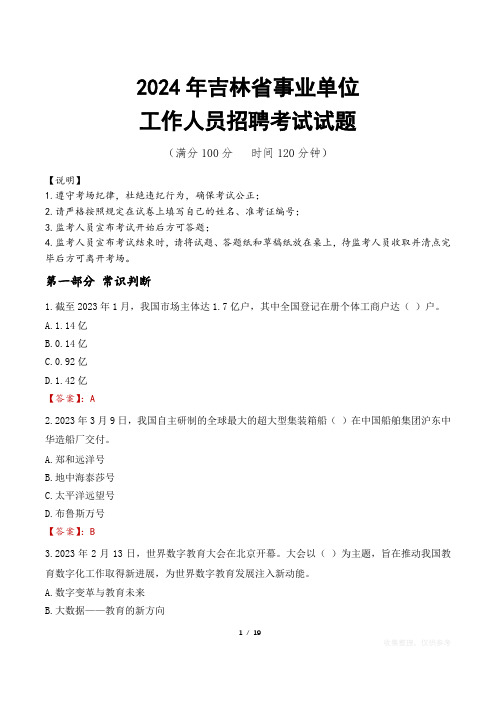
2024年吉林省事业单位工作人员招聘考试试题(满分100分时间120分钟)【说明】1.遵守考场纪律,杜绝违纪行为,确保考试公正;2.请严格按照规定在试卷上填写自己的姓名、准考证编号;3.监考人员宣布考试开始后方可答题;4.监考人员宣布考试结束时,请将试题、答题纸和草稿纸放在桌上,待监考人员收取并清点完毕后方可离开考场。
第一部分常识判断1.截至2023年1月,我国市场主体达1.7亿户,其中全国登记在册个体工商户达()户。
A.1.14亿B.0.14亿C.0.92亿D.1.42亿【答案】:A2.2023年3月9日,我国自主研制的全球最大的超大型集装箱船()在中国船舶集团沪东中华造船厂交付。
A.郑和远洋号B.地中海泰莎号C.太平洋远望号D.布鲁斯万号【答案】:B3.2023年2月13日,世界数字教育大会在北京开幕。
大会以()为主题,旨在推动我国教育数字化工作取得新进展,为世界数字教育发展注入新动能。
A.数字变革与教育未来B.大数据——教育的新方向1/ 19C.数字化转型推动大学发展D.立德树人:教育的目的【答案】:A4.()标志着中国古代数学形成了完整的体系。
A.《墨经》B.《九章算术》C.《孙子算经》D.《周髀算经》【答案】:B5.资产阶级国家参与社会再生产的目的是()A.合理配置资源,提高社会生产力;B.实现供求总量平衡,调整优化经济结构;C.保证垄断资产阶级获得高额垄断利润D.实现充分就业;【答案】:C6.孔庙在中国历史上是推广儒家教化而兴建的重要礼制性建筑,几乎遍布全国各地。
其中有一座庙被称为宗庙,该庙位于()。
A.扬州B.苏州C.台州D.衢州【答案】:D7.中国历史上儒家思想经过2000多年的不断发展形成了较完整的理论体系。
其中荀子对儒家思想的改造主要表现为()。
A.提出“天人感应”B.主张“礼法并用”C.提倡“以德服人”D.提倡“仁政”【答案】:B8.下列不适用于命令的是()。
2/ 19A.宣布施行重大强制性行政措施B.嘉奖有关单位及人员C.依照有关法律公布行政法规和规章D.对重要事项或者重大行动做出安排【答案】:D9.公共财政的出发点和落脚点是()。
扬州市专业技术人员继续教育网考试《专业技术人员创新能力》第二套试题100分标准答案8页
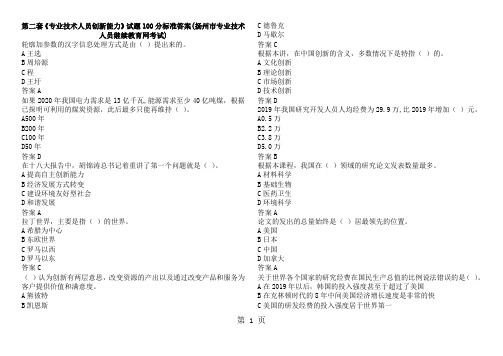
第二套《专业技术人员创新能力》试题100分标准答案(扬州市专业技术人员继续教育网考试)轮廓加参数的汉字信息处理方式是由()提出来的。
A王选B周培源C程D王圩答案A如果2020年我国电力需求是13亿千瓦,能源需求至少40亿吨煤,根据已探明可利用的煤炭资源,此后最多只能再维持()。
A500年B200年C100年D50年答案D在十八大报告中,胡锦涛总书记着重讲了第一个问题就是()。
A提高自主创新能力B经济发展方式转变C建设环境友好型社会D和谐发展答案A拉丁世界,主要是指()的世界。
A希腊为中心B东欧世界C罗马以西D罗马以东答案C()认为创新有两层意思,改变资源的产出以及通过改变产品和服务为客户提供价值和满意度。
A熊彼特B凯恩斯C德鲁克D马歇尔答案C根据本讲,在中国创新的含义,多数情况下是特指()的。
A文化创新B理论创新C市场创新D技术创新答案D2019年我国研究开发人员人均经费为29.9万,比2019年增加()元。
A0.5万B2.2万C3.8万D5.0万答案B根据本课程,我国在()领域的研究论文发表数量最多。
A材料科学B基础生物C医药卫生D环境科学答案A论文的发出的总量始终是()居最领先的位置。
A美国B日本C中国D加拿大答案A关于世界各个国家的研究经费在国民生产总值的比例说法错误的是()。
A在2019年以后,韩国的投入强度甚至于超过了美国B在克林顿时代的8年中间美国经济增长速度是非常的快C美国的研发经费的投入强度居于世界第一第 1 页D英国就研究经费的投入上占GDP之比是逐年下降的答案C本课程提到,我国自主创新主要是指()创新。
A市场B技术C管理D组织答案B现有技术集合在一起,开发一种新的产品,而不是单纯的模仿的是属于()。
A原始创新B集成创新C消化吸收再创新D合作创新答案B技术发明成果的产业化过程要跨越创新过程中的()。
A“拉美陷阱”B“凯恩斯海”C“死亡之谷”D“思想陷阱”答案C根据本课程,专利申请量最大的是()。
日本幼儿园教育振兴计划的主要内容和意义
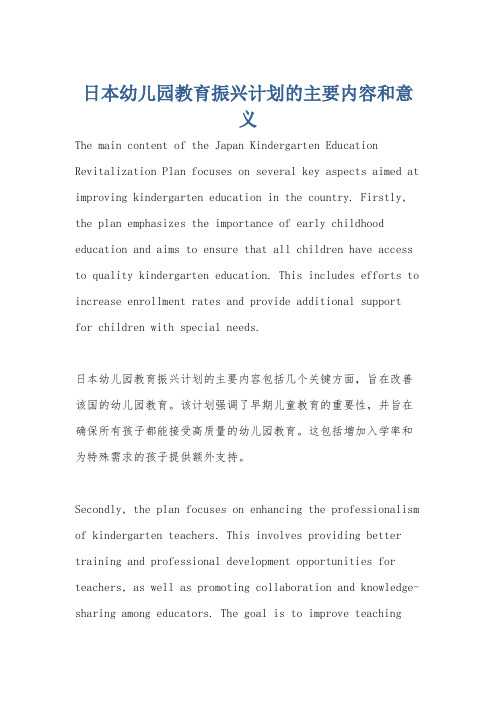
日本幼儿园教育振兴计划的主要内容和意义The main content of the Japan Kindergarten Education Revitalization Plan focuses on several key aspects aimed at improving kindergarten education in the country. Firstly, the plan emphasizes the importance of early childhood education and aims to ensure that all children have access to quality kindergarten education. This includes efforts to increase enrollment rates and provide additional supportfor children with special needs.日本幼儿园教育振兴计划的主要内容包括几个关键方面,旨在改善该国的幼儿园教育。
该计划强调了早期儿童教育的重要性,并旨在确保所有孩子都能接受高质量的幼儿园教育。
这包括增加入学率和为特殊需求的孩子提供额外支持。
Secondly, the plan focuses on enhancing the professionalism of kindergarten teachers. This involves providing better training and professional development opportunities for teachers, as well as promoting collaboration and knowledge-sharing among educators. The goal is to improve teachingquality and create a supportive environment for both teachers and students.该计划注重提升幼儿园教师的专业水平。
乡村振兴和教育现代化背景下中学数学教学研究 (2)

乡村振兴和教育现代化背景下中学数学教学研究一、当前,我国正面临两个复杂而难题,即逐渐逼近中等发达国家的阶段,一方面要积极发展实体经济,推进乡村振兴,另一方面需要努力推进教育现代化进程,培养更多的人才。
乡村振兴的成功需要在教育领域起到土壤滋润的作用。
数学这门科目作为基础科学,是现代教育的重要内容,也是乡村教育的核心课程之一。
因此,如何推进数学教学的现代化,发挥数学的作用助力乡村振兴,是当前教育界探求并亟待解决的问题。
本文在分析当前中国乡村发展现状和数学教育现状的基础上,提出了加强数学教育现代化的必要性,并以典型的事例为基础,探讨教育现代化对于乡村振兴的重要作用。
二、乡村振兴与数学教育现代化的关系1.当前乡村发展现状目前,中国是一个城乡结合的国家,城区与农村区域发展极不平衡。
农村地区人口流失严重,导致经济萎缩、功能失调、不平衡发展等问题。
当前中国政府提出了“乡村振兴战略”,通过实施一系列政策措施,增强农村市场、资源、科技和人才等综合实力,促进乡村发展和现代化进程。
2.当前教育现代化的必要性随着人们对教育的认知逐渐深化,传统的教育方式已难以适应当代人才培养的需要。
当前的教育现代化不仅是一种教育思想的创新,更是一种科技手段的创新,是一种教育目标的全面提升。
在推进乡村振兴的同时,也需要借助教育现代化的力量,助力乡村的人才培养和社会进步。
3. 数学教育现代化与乡村振兴数学学科是基础学科,是现代教育的重要内容。
数学学科不仅在学科本身的研究上有用途,同时也是一项人才培养和科技创新的重要基础。
数学学科的显著特点就是精密、规律、抽象和优美。
通过现代化的手段,如互联网、大数据、智能化等,可以更好地展现数学的特点,激发学生的兴趣和积极性,在培养高素质人才的同时,也可以促进乡村教育现代化的进程。
三、提高数学教育现代化水平的具体做法1. 运用信息技术手段信息技术在教育中具有相当重要的作用。
通过采用先进的信息技术手段,比如图像处理、实时交互、3D仿真等,可以丰富教学手段,更形象直观地展现数学的精髓,增强学生的学习兴趣,提高学生的学习效果。
数学的趣味历史揭秘数学在古代日本的发展
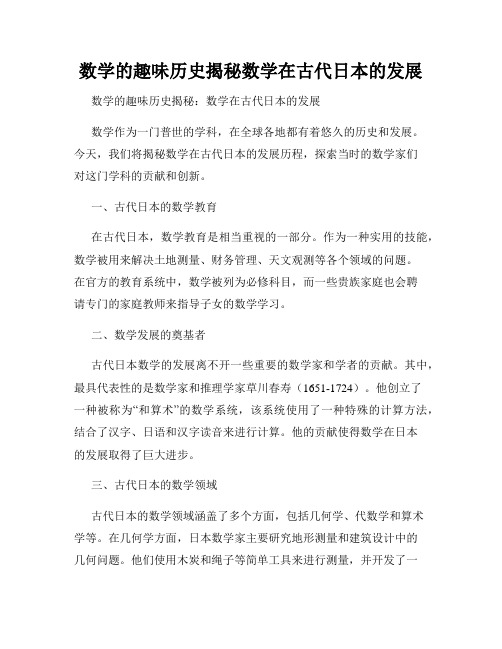
数学的趣味历史揭秘数学在古代日本的发展数学的趣味历史揭秘:数学在古代日本的发展数学作为一门普世的学科,在全球各地都有着悠久的历史和发展。
今天,我们将揭秘数学在古代日本的发展历程,探索当时的数学家们对这门学科的贡献和创新。
一、古代日本的数学教育在古代日本,数学教育是相当重视的一部分。
作为一种实用的技能,数学被用来解决土地测量、财务管理、天文观测等各个领域的问题。
在官方的教育系统中,数学被列为必修科目,而一些贵族家庭也会聘请专门的家庭教师来指导子女的数学学习。
二、数学发展的奠基者古代日本数学的发展离不开一些重要的数学家和学者的贡献。
其中,最具代表性的是数学家和推理学家草川春寿(1651-1724)。
他创立了一种被称为“和算术”的数学系统,该系统使用了一种特殊的计算方法,结合了汉字、日语和汉字读音来进行计算。
他的贡献使得数学在日本的发展取得了巨大进步。
三、古代日本的数学领域古代日本的数学领域涵盖了多个方面,包括几何学、代数学和算术学等。
在几何学方面,日本数学家主要研究地形测量和建筑设计中的几何问题。
他们使用木炭和绳子等简单工具来进行测量,并开发了一套准确的计算方法。
在代数学方面,数学家们通过研究方程式和等式解决了很多实际问题。
此外,在算术学领域,数数游戏和计算技巧成为了古代日本教育中的重要组成部分,帮助学生们培养了计算能力和逻辑思维。
四、数学的应用领域古代日本数学的发展也与其他领域的实际应用紧密相连。
特别是在军事方面,数学在兵法、战略和战术领域发挥了重要作用。
数学家们研究军事战场上的距离、角度和速度等问题,为决策者提供了有力的支持。
五、数学带来的文化影响数学不仅仅在日本的实用领域发挥作用,它还对当地文化产生了深远的影响。
数学的发展促进了日本与其他亚洲国家(特别是中国和韩国)之间的交流与合作。
此外,数学的教育也被看作是一种培养认真和纪律的重要途径,塑造了当时日本人的价值观和思维方式。
六、古代日本的数学遗产古代日本数学的发展成果体现在很多遗迹和文物中。
- 1、下载文档前请自行甄别文档内容的完整性,平台不提供额外的编辑、内容补充、找答案等附加服务。
- 2、"仅部分预览"的文档,不可在线预览部分如存在完整性等问题,可反馈申请退款(可完整预览的文档不适用该条件!)。
- 3、如文档侵犯您的权益,请联系客服反馈,我们会尽快为您处理(人工客服工作时间:9:00-18:30)。
Science in junior 4th/38countries 6th/46countries 3th/50countries high school
※TIMSS: Trends in International Mathematics and Science Study ※IEA: The International Association for the Evaluation of Educational Achievement ※surveyed object : Forth graders and eighth graders
50 40 5th
6th math
48.8 7th
47.1 44.6
8th
9th grade
science
Source: MEXT, FY2003
* MEXT: the Ministry of Education, Culture, Sports, Science and Technology
4
Teachers, do you think you are good at teaching
- priority field to be promoted
・Reforming the S&T system
- Doubling competitive research fund - Enhancing industryuniversity-government collaboration ・Producing as many as 30 Nobel laureates in 50 years
The teacher 0% who answered
good is 0%.
science?
20%
40%
60%
80%
100%
good
fairly good
fairly poor
poor
no response
Do you think you like science in general?
0%
20%
40%
Vision
To support development and activities of personnel who are to advance and deploy science and technology, while enhancing science communication between the public and S&T related professionals.
respondents like science in general.
* surveyed on elementary class teachers experienced for less than 5 years
Source: JST and NIER, “The Survey on Science Education in Elementary and Lower-Secondary schools in FY 2008.”
Literate
Chapter 5 Role of for S&T the Council Policy
a person who has knowledge and abilities relating to S&T 7
To develop individuality and ability To raise interest and eagerness
Japan Intercollegiate
Science Championships
Development Programs for
5
The Science and Technology Basic Law
(established in 1995)
Science and Technology Basic Plan
The 3rd Basic Plan (FY2006~FY2010)
The 2nd Basic Plan (FY2001~FY2005) The 1st Basic Plan (FY1996~FY2000)
Scientific literacy
2nd/32countrie 2nd/41countries,areas
s
※PISA: Programme for International Student Assessment
※surveyed object : Tenth graders
6nd/57countries,areas
・R&D evaluation
●3 basic concepts
・creation of wisdom ・vitality from wisdom ・sophisticated society by wisdom
●Core policies
・Strategic priority
- promotion of basic research
Source: TIMSS 2007
% 80
74.2
The ratio of students who like
70
studying math and sc64.1 59.2
61.3
58.7
65.4 tends to decline as the grade gets higher.
Supporting System for Science and Mathematics
:in schools :out of schools
Universities
Education in Japan
Systematic promotion of human resources development enabling the abilities to advance continuously according to the developmental stages
The ranks of Japanese school children are moving down in the lists of PISA and TIMSS, though they are still high.
3
Do you like mathematics and science?
60%
80%
100%
like a lot
like
dislike
dislike a lot
no response
The ratio of those who are good at teaching science is 0%
and fairly good is less than 40%, but about 90% of the
Chapter 4 S&T to Be Supported by Society and the Public
●Responsible measures to resolve ethical, legal, or social problems ●Accountability relating to S&T and the improvement of information
Chapter 1 Basic Ideas Chapter 2 Strategic Priority Setting in S&T
A portrait of human resource in S&T
Chapter 3 Reforming the S&T System
●Developing, securing and activating human resources ●Creating scientific development and persistent innovation ●Reinforcing the foundation for promoting S&T ●Strategically promoting international activities
● Increasing governmental R&D expenditure
● Building a new R&D system
・Increasing competitive research fund
・A program to support 10,000 postdoctorals
・Promoting human interaction among industry-universitygovernment
transmission ●Improving the public awareness of S&T ●Promoting proactive participation of the public in S&T
Innovator
The innovation is: to generate new social and economic values with advanced scientific findings and technical inventions combined with human insights.
TIMSS(surveyed by IEA)
Results of Arithmetic / Mathematics and sciences
<Japan>
‘95
‘03
‘07
‘95
‘03
‘07
Arithmetic
3rd/25countries 3rd/25countries 4rd/37countries
